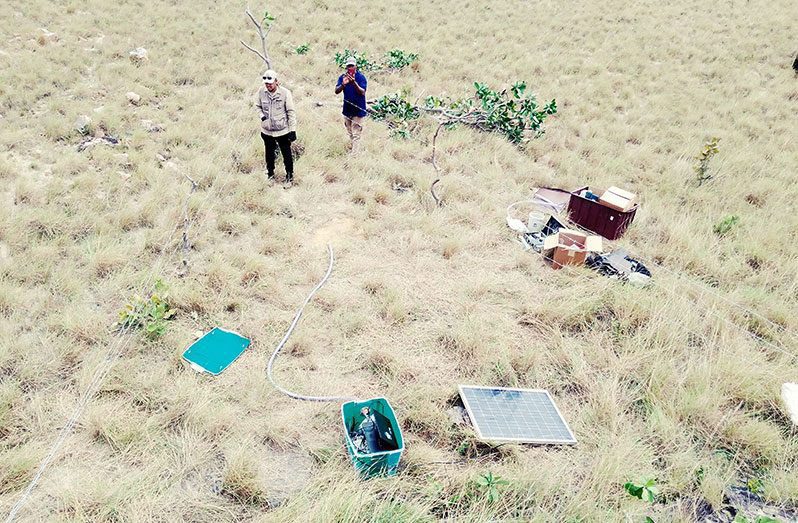–Geologist says that big ‘aftershocks’ are dwindling
THOUGH there are concerns among the residents of the ‘Deep South’ area in Region Nine (Upper Takutu-Upper Essequibo) over the continued aftershocks (or tremors), Geologist Javed Baksh, who has been working in the area, stated that the intensity of the aftershocks was dwindling, signalling that most of the earthquake’s energy had been depleted.
The region was the epicentre of a massive 5.7 earthquake on January 31, which was felt across Guyana and in parts of Brazil. Since that occurrence, the ‘Deep South’ area, particularly the communities of Aishalton, Katoonarib and Sawariwau, have been affected by continuous aftershocks.
Baksh, who is a Geologist with the Guyana Geology and Mines Commission (GGMC), told the Guyana Chronicle that the authorities do not have enough information as yet to determine when these aftershocks will end. In fact, he reminded the newspaper that it was only recently that a multi-stakeholder team, including himself, installed equipment to monitor seismic activity in four different locations in the south Rupununi area.
“Right now, what we can say is that most of the energy (of the earthquake) has expended,” the Geologist highlighted, adding: “That is the general thought but going forward, how much will be released, how much more stored up, we don’t have an actual measure.”
Professor at the São Paulo University, Marcelo Sousa de Assumpção, who has been working with the team, explained, during a recent virtual meeting, that most of the aftershocks (or tremors) will occur in the same faults where the original earthquake occurred. These aftershocks can be used to study the properties and the geology of the main shock (the January 31 earthquake).
The professor further explained that an earthquake occurs when the rocks or faults on the earth’s crust can no longer sustain the stress (or pressure) that it has been experiencing for a very long time. At that point, there is a sudden movement, known as a failure, that generates a very strong vibration. He explained that sometimes, some parts of the fault may still have some stress to release, thereby resulting in the aftershocks. And this has been the case in the ‘Deep South’ area, where the fault running across the region has been releasing these aftershocks.
Baksh, who is part of the team responsible for retrieving data from the seismometers on a weekly basis, said that the second earthquake was not necessarily a significant earthquake. Before the massive 5.7 magnitude earthquake, there were foreshocks (tremors occurring beforehand) dating back to December 2020. That massive earthquake, Baksh explained, is expected to be the ‘peak’ of the seismic activity occurring there; this means that the ensuing seismic activity would not have such a great magnitude.
“On that principle alone, we know that the biggest shaking has passed,” the Geologist explained. He also noted that from the data the local authorities do have, they do not believe that the seismic activity would last for an extended period of time.
RESIDENTS FEARFUL
Meanwhile, residents in these three communities have expressed their fears over the seismic activity occurring in the area. The Deputy Toshao of Katoonarib, Floria Singh, shared that she has not been able to sleep well over the past two months because of the continuous vibrations.
She also noted that many of her villagers have complained of migraines and anxiety since the unpredictable occurrences have been adversely impacting them. Following Friday’s earthquake, she highlighted that the villagers are, once again, in a state of confusion.
The GGMC Geologist highlighted that the GGMC has been engaging the communities on an ongoing basis. During an interview with the Guyana Chronicle on Friday, Preparedness and Response Manager (ag) of the Civil Defence Commission (CDC), Major Salim October highlighted that the commission is working on a medium to long term plan to help the affected communities respond to these largely unpredictable occurrences.
“At the moment, the CDC is gonna be looking at a more medium to long term process which will include Katoonarib and Sawariwau in the community-based risk-management system,” he said, emphasising: “We will commence discussions with those communities with the aim of developing community-specific plans and we will be working with them to develop an earthquake response plan which forms the basis of an annex to their recent disaster-risk-management system.”
He noted that there is no timeline guiding the development of this plan as yet but hastened to add that such a response is needed in the fastest possible time.





.jpg)








